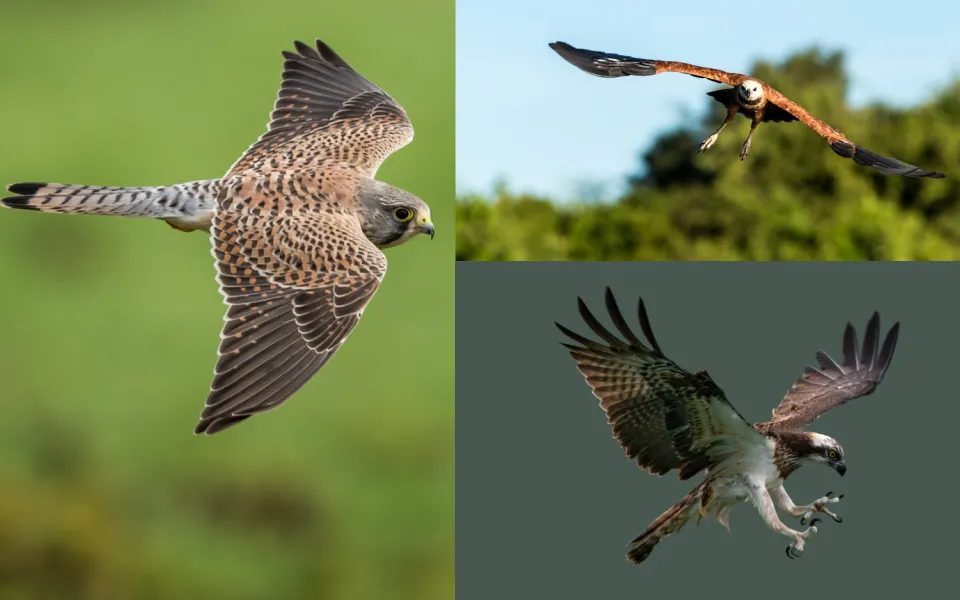If you want to fly birds, it’s pretty inevitable that a hawk of some sort will eventually grace you with its presence. Losing your birds to hawks could become an ongoing heartbreaking event, or (if you read this article) it could be an eye-opening education in how to avoid this altogether. You need to “train the hawk.”
What Are Hawks:
Hawks are birds of prey that belong to the Accipiter family, which is also part of the Raptor group. This Accipiter family is made up of approximately 51 species of bird hawk. These hawks mainly prey on other birds. There are approximately 270 species of hawks found worldwide, except in Antarctica.
TYPES of Accipiter—Raptor Hawks:
I regularly see Northern Goshawks, Broad-winged Hawks, Peregrine Falcons, Sharp-shinned Hawks, Cooper’s Hawks, Red-tailed Hawks, and Red-shouldered Hawks passing through my area.
Now, to put things into perspective, the Falcon, being one of the fastest predators, will use a variety of techniques in their quest for a meal, such as seeking out, pursuing, attacking, and killing their prey. Falcons have excellent eyesight and can see their prey up to one mile away. A Falcon is able to dive, or stoop, at 185 mph or faster to catch its prey; they catch it in midair, at which point the speed alone kills the prey instantly.
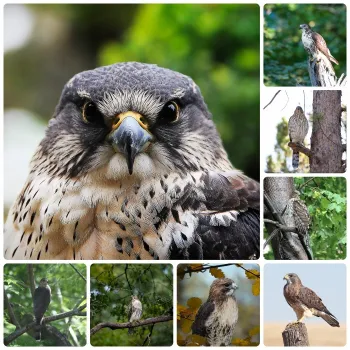
Unlike owls, falcons, along with all the other hawks, hunt during the day. In my area, Cooper Hawks are the most frequented and problematic. So, if you are outside and your birds are out flying, there is a good chance you will encounter a hawk of some sort at some point in the near future.
My dad has always had to stay vigilant while flying his racing homers. Before moving to the United States as a young man, he learned valuable tips from old timers in Germany. He learned more techniques over the years as he raced his pigeons. Because the bloodline he created and critiqued over the years brought him recognition and notoriety in the AU Racing community, you can bet he did everything he could to protect those winning birds and bloodline. So now I am going to attempt to pass on that very wisdom he bestowed upon me to help you with your birds as it has helped me with mine.
Where To Begin:
Ok, so as I stated earlier, if you are going to fly your birds, then it’s unrealistic to think you won’t have to deal with the impending hawk situation at some point along the way. Let’s face it, whether we like it or not, hawks are a big part of raising pigeons. Now for beginners who are just starting out with pigeons, how you handle your hawk situation from that day forward will determine if you will have a revolving door of pending hawk visits. For those of you that have pigeons and have been dealing with the never-ending loss of pigeons to hawks, hopefully I can offer you some pointers on how to untrain the hawks you have already trained.
Understanding a Hawk:
Hawks wake up early each morning at first daylight. Now they have but one mission on their mind: seek out, catch, and eat that one meal each day. They usually only hunt, catch, and eat once a day. A hawk (if successful) should normally be done hunting by noon or thereabouts each day. So, with that said, if you are experiencing a frequent hawk disturbance in the morning, change your routine. If you let your birds out to fly each morning around 10 a.m. and a hawk swoops in there after while your birds are out flying, and you continue to let your birds out each morning around 10 a.m. even though you know you have a hawk problem, then you are inadvertently training that hawk to have its feeding time every day around 10 a.m. You might as well ring the bell and yell, “Come and get it!”
Let’s Dive In:
Now, I know what you might be thinking… huh… What do you mean? I can’t train a hawk. Well, actually, you can and you are. Little do you realize, every action in turn gets a reaction, thereby resulting in you training the hawk to feast on your pigeons. By now, some of you are getting a bit upset over my insinuation that you are the cause of your lost pigeons. Well, let me just put this out there… I’m not here to make you feel good; I’m here to help educate you so you can stop losing pigeons to hawks. So let’s continue. First and foremost, before we even enter our pigeon lofts, we go outside and scan the sky and trees for any sign of a hawk. If we see one, we don’t let our flyers out. We will wait till later and check again.
When we fly our young birds, we are outside with them. We enjoy watching them while at the same time keeping our eyes peeled for any dangers lurking in the distance. If I spot a hawk while my birds are up in the air, I will immediately start yelling, screaming, whistling, clapping my hands, waving my arms about, and throwing my hat up in the air. My dogs are quite helpful by joining in with their barking and running back and forth across the yard, jumping up in the air. I’ve even gone so far as to bang and clang pots and pans together or a big aluminum shovel against a metal pipe. Anything to cause a loud ruckus and scare the hawk off. This usually works.
We try very hard to NEVER let a hawk catch its meal with one of our pigeons. If that or any other hawk comes back in the future, we will repeat this same process. Each time you succeed in causing the hawk to forfeit its meal, the less likely it will be to want to return to try again.
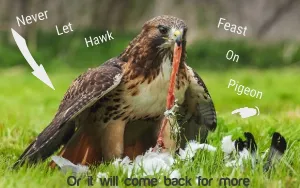
Now, should a hawk actually successfully catch one of my pigeons in mid-air, the hawk will immediately take it to the ground to feast on it. So, now you’re thinking, yep seen that happen, Right? Well, I don’t stop there. I sprint as fast as I can to where I see the hawk land with my pigeon. My dogs will run ahead of me, scaring that hawk right back up in the air just as fast as it landed. The hawk will want to get the heck out of dodge as fast as possible with all my dogs and a human heading straight for it. The hawk will take off, leaving my dead pigeon behind, lying on the ground. I will then go pick it up and dispose of it. Now why do I do this, you ask? I am ensuring the hawk is still hungry. Why do this? Why does it matter? The pigeon is already dead. Yes, but remember earlier when I said you needed to learn how to train a hawk the correct way? Well, this is part of that training. Keep reading….
Following My Own Advice:
About a month ago, we had another large snowfall, so I was out shoveling snow around my lofts and letting my birds out to fly. It was one of those nice, rare warmer days with very light winds at the end of January. While I was out, I instantly noticed all my other birds piling back into their coops from their fly-pens. I looked up, and what do I see? A young Cooper Hawk, coming straight for my flyers. My flyers know I am out there with them, so they are already programmed to know that I will do everything I can to keep them safe. So, while I’m out scaring the hawk away from them, my flyers will immediately come down and go straight into the coop. Now, if a hawk showed up while I was busy doing something elsewhere like inside my garage, and I did not see what was happening at the time, then my flyers would send themselves high up in the sky to the point I could hardly see them to try and keep themselves safe from the pending hawk.
Now, back to making my point about utilizing the advice I’ve been giving you… Lol. When I locked eyes with that hawk, I immediately took the big aluminum shovel I was using for shoveling snow and banged it on the metal fly pen fencing as I was yelling. I then started waving my arms up in the air like I was flagging down an airplane. I then saw that young Cooper hawk land in a nearby tree on the outskirts of my woods. So what did I do? I ran toward that very tree, still staring right at it. So that hawk, seeing me coming, knew I was still pursuing it and did not want it there, so that hawk flew away. I have not seen it since.
The moral of this story and the advice I am giving you is simply put: “Don’t feel defeated; be proactive and show the hawks you’ve now become their predator.” You have to make the hawks feel unsafe in your area and in your presence. You wouldn’t let a bully on the schoolyard bully your child if you were standing right there, would you? So think of your pigeons as your children and the hawk as the schoolyard bully you are intimidating into flying away. Hence, you are now “Training the Hawk” there is a new sheriff in town, and their hunting ground is no more. But, remember, you will have to be very consistent and not slack off or let any hawk actually eat any of your pigeons, even if a hawk should actually catch one of your pigeons.
So What’s Next:
Well, naturally, you stop letting the birds out around 10 a.m. You could put them in their fly pen for a few days and then switch the time. Let them out in the afternoon, for example, around 3 p.m. A hawk gets really nervous if they have not found a meal by late afternoon, so they will do everything they can to find their meal as early as possible. You are now safe after a hawk has eaten its daily meal elsewhere and then decides to fly over your pigeons while they are out. At this point, the hawk is just having a little fun scaring your pigeons, but will not attack any of them. Or, they will just pass right on through without bothering your birds at all. As I mentioned, a hawk will only eat one bird a day. Now, in the case of two hawk sightings together, they are usually a mated pair with babies in the nest they need to feed. The male will usually glide above your pigeons, freaking them out so they will start to scatter from the kit, while the female comes out of nowhere and swoops in for the kill. These parents are on a mission, and if they discover your kit as plentiful easy prey, you can bet they will make your birds their feeding ground each and every day. Now, in this case, I would say their nest is quite a ways from your location. Interesting fact: If a hawk has a nest on or right near your property where you keep your birds, they are less likely to hunt your pigeons. They will stay away while the babies are small and growing in the nest, BUT when the babies are old enough to learn to hunt for themselves, then watch out. The parents will save your pigeons to teach their young how to hunt. Now you’ve got a problem, so do not let your birds out during the mornings or even early afternoons. Those parents will have to then take their babies off to a distant location to get a meal. So, hopefully they will have been successful elsewhere by the time you let yours out in the late afternoon.
Hawk
Deterrence:
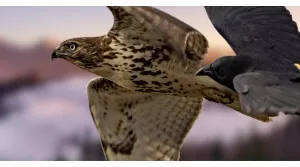
So now we’re going to talk a bit about how you can deter a hawk altogether. We’ve already discussed the various methods for scaring a hawk away from your kit. But what about ways to prevent his arrival in the first place. One word: crows. Crows are relentless when it comes to hawks, as they too want them out of their area. When crows spot any species of hawk or eagle, they will band together and chase, circle, and screech at a hawk until it leaves. Basically, a crow will literally announce a hawk’s presence in the area well before you are even able to spot it yourself. So how do you coax a crow or a family of crows to move in, set up shop, and nest in your trees year-round?
- Install a crow feeder and keep a steady supply of food in it.
- Place a pan on top of a post with a bracket to keep it high off the ground but low enough that you can reach it. Fill it with random foods that crows like, such as:
- Dead mice or shrews—caught in your mouse traps
- Fish guts or carcasses—when you clean your fish
- Dead snake
- Deer carcass or meat
- Pigeon eggs—any day-old eggs if you don’t want your pigeons to hatch more babies
- Bread
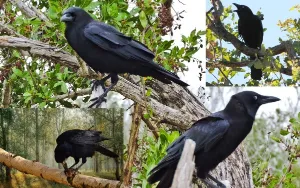
- Corn
- French Fries
- Berry or Melon Fruits
- Small-sized dog or cat foods
- Etc.… the list goes on and on
- Crows enjoy eating a wide variety of foods. Check online for websites that just talk about crows.
- Keep food readily available for the crows year-round to ensure they will want to stay.

Another Option:
Now, some may say all hawks are bad, but in reality, not all hawks feed on pigeons. I’m not saying they won’t feed on pigeons, but there are some that, surprisingly enough, a pigeon is not their preferred meal of prey. For example, the common Red-tailed hawk prefers rodents, reptiles, and other small mammals. Hawks are very territorial, meaning a hawk will claim a certain territory and defend it at all costs. So, what does this mean, exactly? Well, for instance, if a common Red-tailed hawk lives on or near your property and, let’s say, a Cooper hawk wanted to move in, that Red-tailed hawk would fight and fend off the Cooper until it left and moved on elsewhere. So, if you have a Red-tailed hawk setting up shop in one of your nearby trees, that is not the worst-case scenario. That Red-tailed hawk will, in most cases, go out hunting elsewhere and usually leave your pigeons alone, while keeping all other hawks at bay and out of your area. At least that has been the case for us over the years.
In Conclusion:
I hoped I was able to offer some sound and useful advice to help ward off your next unwanted intruder. Knowing it was possible to actually train a hawk to move on and feed elsewhere was empowering for me when I learned these tricks. But in order for any of it to work, you must stay alert and vigilant. You can’t slack; you must stay on top of the situation. We have a few hawks here and there throughout the summer, as well as a few in the winter. But, thankfully, we rarely lose any birds to hawks. But rest assured, when I do, I will make sure that hawk never gets to eat it. We are always vigilant. It doesn’t hurt that I have several chicken roosters who are very good at sounding the alarm whenever a hawk approaches our airspace. Also, watch your other pigeons. When, out of nowhere, I see all my pigeons starting to pile into the coop on a nice day, I will immediately start calling my fliers down to go in. At the same time, we are running our dogs, making them bark to cause a ruckus, while the roosters continue to crow and my chickens start cackling, to make the hawk not want to come our way and hopefully turn in a different direction. Keep some old pots and pans handy and make lots of noise. Well, that’s all for now; drop us a line if you have any questions.

